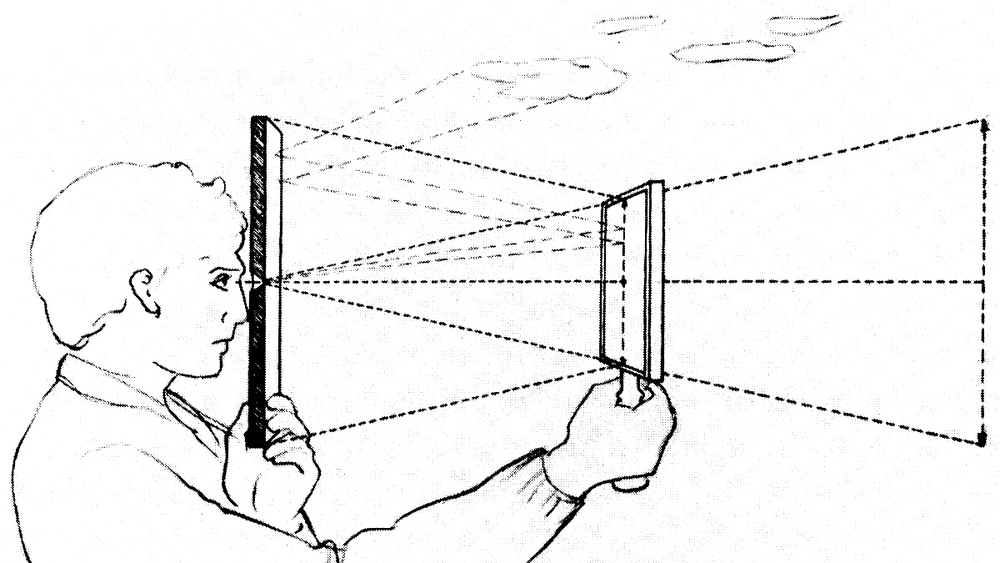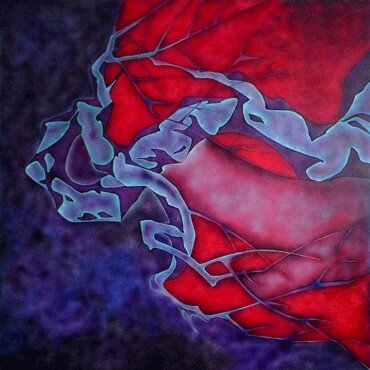Martina Fischer:
The /Undefinable/
March 2013
The only painting worth looking at has the same raison d’être as the raison d’être of the world—mystery.[1] —René Magritte
Tupien I, 2011. Oil and acrylic on canvas, 60 by 60 cm.
Skirting a volcanic eruption traversing the lower and upper armature of a terrestrial realm, the right bank of a frozen stream of cadmium red is delimited through heaps of uncanny rocks bathing in shades of blue and vermillion green spray paint. Here post-painterly colors shout and whisper through the deployment of the anti-gestural that at times refutes verbal categorization of process, as distinctions between modeling through traceless brushstrokes and spray paint are often obscure. On the left bank of this surreal riverscape, massive cellular organisms seem to have reached out as celestial shoots from the leafless branches peculiarly suspended over the right shore—paradoxically integrated with the shoreline while floating in space. Nearly hallucinatory yet frozen, Tupien I of Martina Fischer reformulates modernism’s proviso of form, overturning abstraction’s early twentieth century’s meteoric embracement of flatness that would become virtually canonical within the hegemonic theories and practices of painting. Nor does Fischer straightforwardly subscribe to the gestural practices of abstract expressionism, although the possibilities of chromatic chance are innumerable within the confines of linear contours. This hyper-abstraction of Fischer presents itself as an alternate route toward revisiting and reformulating “illusion” and “abstraction” at once, generating a form of illusory abstraction that is fabricated by design and control, without necessarily eliminating the happenstance and improvisational. In fact, it is this very dialectical interaction that the paintings of Fischer consistently convey: precision and estimation, order and disarray, lucidity and deep shadow, illusion and abstraction, traditional academic techniques and spray paint, relatively definable form and rather undefinable content.
Tupien II, 2011. Oil and acrylic on canvas, 60 by 60 cm.
While Tupien II preserves the opulent palette and overall rhythm that emanates from Tupien I, a second stream of red lava seems to have become solidified within crevices of a green-blue geological foundation of an imaginary setting. An organic form emerges from the lower side of the painting, suggesting a hybridized tree and insect that suspends the closure of meaning, transferring semantics onto semiotics. The viewer’s apprehension thus becomes suspended between the explicable and inexplicable.
Illustration of Brunelleschi’s experiment that pairs the illusion of architectural perspective and abstraction of the temporality of clouds. In Hubert Damisch, A Theory of /Cloud/: Toward a History of Painting. This diagram was originally published in Alessandro Parronchi, Studi su la dolce Prospettiva (Milan: Aldo Martello Editore, 1964).
In a seminal book entitled A Theory of /Cloud/: Toward a History of Painting, Hubert Damisch establishes a semiotic approach to the history of art, whereby meaning is fundamentally constructed through the binary opposition of parameters within a given system: that the definable exists in its very relation to what is undefinable; that illusion and abstraction go hand in hand in one way or another. Thus Damisch brackets the term /cloud/ with two forward slashes in order to render the term as a signifier (form) as opposed to a signified (meaning). Accordingly, a series of contraries are generated: /architecture/ versus /cloud/, /illusion/ versus /abstraction/, /permanent/ versus /ephemeral/, /definable/ versus /undefinable/, /geometric/ versus /organic/. The presence of a given concept, therefore, inescapably necessitates its contrary insofar as the underlying logic of language is concerned. As Jacques Derrida comments on the very nature of language and knowledge, “writing is not only an auxiliary means in the service of science—and possibly its object—but first, as Husserl in particular pointed out in The Origin of Geometry, the condition of possibility of ideal objects and therefore of scientific objectivity. Before being its object, writing is the condition of the epistémè.”[1] Hence thinking, language and visual representation would become relational and inevitably interlocked, as if indivisible. Since the images of Fischer are highly illusionistic yet nonrepresentational, they embody the concept of the /cloud/ versus /architecture/, those parameters of the undefinable versus definable that Filippo Brunelleschi had brilliantly addressed through his perspective experiments at the outset of the fifteenth century. In the process of depicting the Baptistery of Florence upon a panel using orthogonal projection, Brunelleschi would assign the temporality and formlessness of the cloud to a silver leaf that would “demonstrate” the sky of his architectural rendering. Hence the cloud—undefinable, immeasurable and temporal—would become the counterpart of the definable, measurable, and permanent architectural entity—the Baptistery, making the legitimacy of the illusion of architecture and its shading relative rather than absolute. Therefore the intransience of the representation of the Baptistery would become validated not on its own, but fundamentally in relation to the temporality of the cloud. Through this logic, the /definable/ and /undefinable/ construct the validity of both representation and meaning through contrariness.[2]
Tupien IV, 2011. Oil and acrylic on canvas, 60 by 60 cm.
Tupien V, 2011. Oil and acrylic on canvas, 60 by 60 cm.
Just as /architecture/ and /cloud/ would become the epistemological parameters of Brunelleschi’s paradigm of pictorial representation, for Martina Fischer it is the dyad of /illusion/ and /abstraction/ that constitutes a differential system. While Tupien IV and Tupien V retain the abstract narratives of the preceding two paintings, intoxicating tones of turquoise, purple, emerald green, indigo and violet circumscribe the middle red poltergeists. Although these paintings of Fischer call to mind the pictorial vocabularies of such innovative American painters as Raymond Johnson (Cliff Dwellings, No. 3, 1927 for instance), Alexandre Hogue (The Crucified Land, 1939 for instance) or Henrietta Shore (Cypress Trees, Point Lobos, c. 1930 for instance), Fischer acknowledges that the impact of cultures and places upon her output is indefinite.[3] “If I’m compelled to paint using certain techniques of trompe l’oeil, semi-abstracted or abstracted themes, I simply paint. I am fascinated by the works of many periods, cultures, movements and artists I constantly encounter. How can I not admire the precision and eloquence of Donald Judd’s sculptures, for example? Or the negative inner and outer spaces that Rachel Whiteread materializes. Or the gestural bravura of a Rembrandt for instance. Or the iconic imagery of Warhol. I truly adore the work, projects and ideas of Ai Weiwei. But when I return to my studio, I turn the music on and draw and paint and spray. Whether the outcome is fashionable or unfashionable is somewhat irrelevant to me. Could it be that canonical modernism’s brilliant shift into pure flatness as an absolute condition of abstraction has left a certain void that I am attempting to fill in my own ways? I attempt to bring together the coloristic freedom of Kandinsky with the rigid, linear parameters of Mondrian.” If the paintings of Fischer come across as stylized reworkings of Vasily Kandinsky’s Komposition V, VI or VII, for example, they seem to insist on the possibility of linearity to coexist with chromatic autonomy, resonating the advice of Jean-Paul Sartre: “One does not imitate Kafka. One does not rewrite him. One had to extract a precious encouragement from his books and look elsewhere.”[4] “Elsewhere” for Martina Fischer seems to be the “mental landscape.”
Tupien VI, 2011. Oil and acrylic on canvas, 60 by 60 cm.
Several of Fischer’s sojourns to the Far East seem to have influenced her recent works. Consider the branch-like theme that recurs in the Tupien cycle and Kaya, for instance. These works recall the idiom of leafless trees within the output of Guo Xi, the prolific eleventh-century Chinese master of the Northern Song dynasty. But Fischer has noted, “I do not think that my artworks have a direct connection to locations or landscapes. Of course some impressions have had an impact on my artwork, especially from the Far East. But my works are rather extremely open-ended. They are mental landscapes rather than depictions of existing places or works. What I seek is a sense of mystery. Two-dimensional form that conveys the illusion of protrusive masses and recessive spaces that push and pull. It is up to the viewers to unveil their connotations. One thing I want to preserve to some extent in my work is the inexhaustible richness of concepts and techniques that we find in Renaissance, Mannerist and Baroque paintings of Italy, for instance—synthesizing them with other Western and non-Western directions of the past and present.”
Styx, 2011. Oil and acrylic on canvas, 60 by 60 cm.
Whether the central theme of Styx suggests a vegetal or neural network sinuously emerging from and situated within successive, purple-and-grey monolithic objects inhabiting the right and left sections of the picture plane, the bright red middle backdrop seems to thrust its way out of the organic barricade, as if space itself possessed the material hardness of stone. And yet the ethereal dissolution of red with purple is evidenced near the upper picture frame, slightly to the right from the center. Here solidity, the essence of stone, has been transformed into vapor, haze, steam. As exteriority has been transformed into interiority, the distinctions of object, space and image have become convoluted, evoking the concept of corporeity. The visual impression of the viewer, therefore, might as well lead to connect the painting to the phenomenology of perception. As Maurice Merleau-Ponty notes in his essay “Eye and Mind,” “Our science and our philosophy are two faithful and unfaithful offshoots of Cartesianism, two monsters born of its dismemberment.”[5] Merleau-Ponty proceeds his critique of the Cartesian standpoint of perception by noting, “Our organs are not instruments; on the contrary, our instruments are added-on organs. Space is not what it was in Dioptrics, a network of relations between objects such as would be seen by a third party, witnessing my vision, or by a geometer looking over it and reconstructing it from outside. It is, rather, a space reckoned starting from me as the null point or degree zero of spatiality. I do not see it according to its exterior envelope; I live it from the inside; I am immersed in it. After all, the world is around me, not in front of me.”[6]
Giderim, 2011. Oil and acrylic on canvas, 60 by 60 cm.
Martina Fischer’s painting titled Giderim reveals a dichotomy of well-defined and inchoate forms that emerge from one another, meander and submerge onto and into each other. The sharp line seems to insist on eventually immersing itself into a coloristic world where the inside, outside, front and back become undifferentiated. Is color not, after all, the very substance from which line is derived? As surface, volume and depth continue exchanging roles across this pictorial field, the painting suggests an instance of organic construction of matter and mist, borrowed from the earth and sky. It renders itself at once definable and undefinable in appearance and meaning.
Notes
Jacques Derrida, Of Grammatology (1967), trans. Gayatri Chakravorty Spivak (Baltimore, Maryland: Johns Hopkins University Press, 1974), p. 27. Regarding Husserl’s investigation of Western metaphysics, Leah Dickerman aptly notes in her conclusion of “Vasily Kandinsky, Without Words” that “Derrida also notes Husserl’s blind spot, his failure to recognize that all perception is itself framed by speech and cannot exit outside it.” In Inventing Abstraction, 1910-1925, exhibition catalog (New York: The Museum of Modern Art, 2012), p. 53.
See Hubert Damisch, A Theory of /Cloud/: Toward a History of Painting (1972), trans. Janet Lloyd (California: Stanford University Press, 2002). See also Rosalind Krauss, “The /Cloud/,” in Agnes Martin, exhibition catalog (New York: Whitney Museum of American Art and Harry N. Abrams, 1992), pp. 155-165.
See Emily Ballew Neff, The Modern West: American Landscapes, 1890-1950, exhibition catalog (New Haven, Connecticut: Yale University Press, 2006).
Jean-Paul Sartre, What Is Literature?, trans. Bernard Frechtman (Gloucester, Massachusetts: Peter Smith, 1978), p. 221.
Maurice Merleau-Ponty, “Eye and Mind,” in The Merleau-Ponty Aesthetics Reader: Philosophy and Painting, p. 138.
Ibid.







